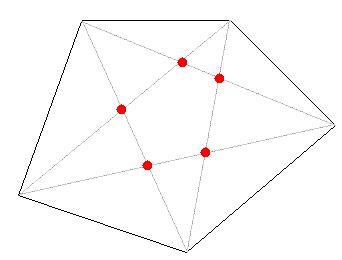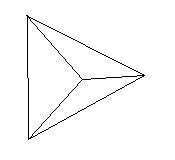
There are N points in a Plane.
All the points are joined with each other. Note that the line segments are made. The lines are not extended on either sides.
They meet at a lot of points.
What is the number of points where these lines meet.
It is known that no 3 points are on the same line!
edit: Nor do any three lines meet at a single point!
Comment: Tough Looking problem with a 1 line solution!
-
UP 0 DOWN 0 2 11

11 Answers
Rider: Dont count the points themselves!
Example:
For this figure, the answer is 5
The red colors are the points of intersection
The outside pentagon is the original set of 5 points.
Not counting the given points ::
The number of points is equal to the ways of choosing 4 points out of the given N points.
This is so because for every 4 points u can draw 2 diagonals with giving u one intersection point.
Answer is NC 4
Edited by : Nishant Sah to make some part invisible to others.. so that they can try without seeing the solution [1]
from now on try to use Hide button to try and hide the answer
when u post answers to this kind of question... so that the other people may no be able to see it unless they select the black area!
I am editing your post to make it look like that...
Hidden Message
Btw ur answer is absolutely correct Rajat :)
Good work
no dear.. this cant be done.. the whole point of the question is that we join only the first n point...
when we do that we get the asterix(star shape) in between...
That is all. We donot want to join any of the points again!
then i think it will be nc4 no of ways of selecting quad out of n points
answer is "somethng <=nC4"
Why i gave this problem is two fold.
1) To highlight this solution
2) To stump those who already knew the solution :P
Actually the problem with this solution as some of u have posted is that there may not be a point inside!
Why? bcos the points are not given to be sides of a convex polygon!!!
I will give an example to drive home my point....

Here, there are 4 points.. the three of the triange and the other 4th point in between. Do these 4 points when joined meet at any point?
NO
So u guys have made a mistake.
But atleast the way u thought was correct!
So u inspite of being a bit ahead of the curve.. failed!
The answer is that we know only an upper limit to this .. that is nC4
opse i got trapped....
Actually this problem was in FIITJEE package and with convex. I solved that there, so in a flash (also due to that conves fig) i got that answer although i checked that no two intersections coincides but finally......................................